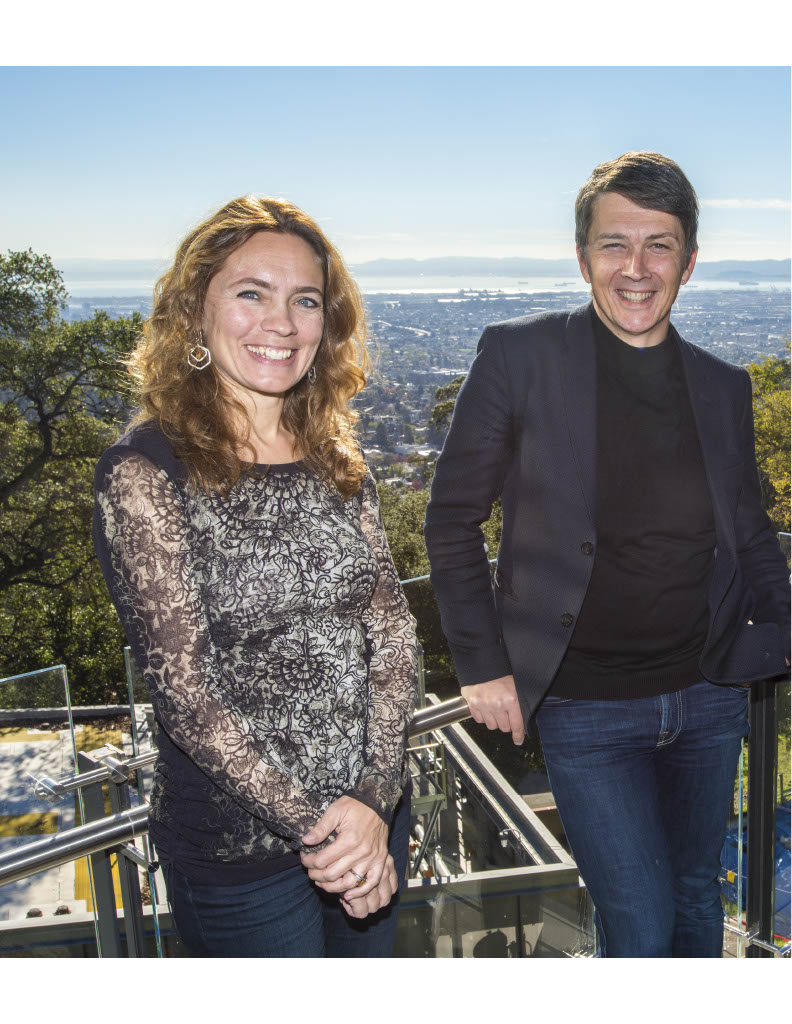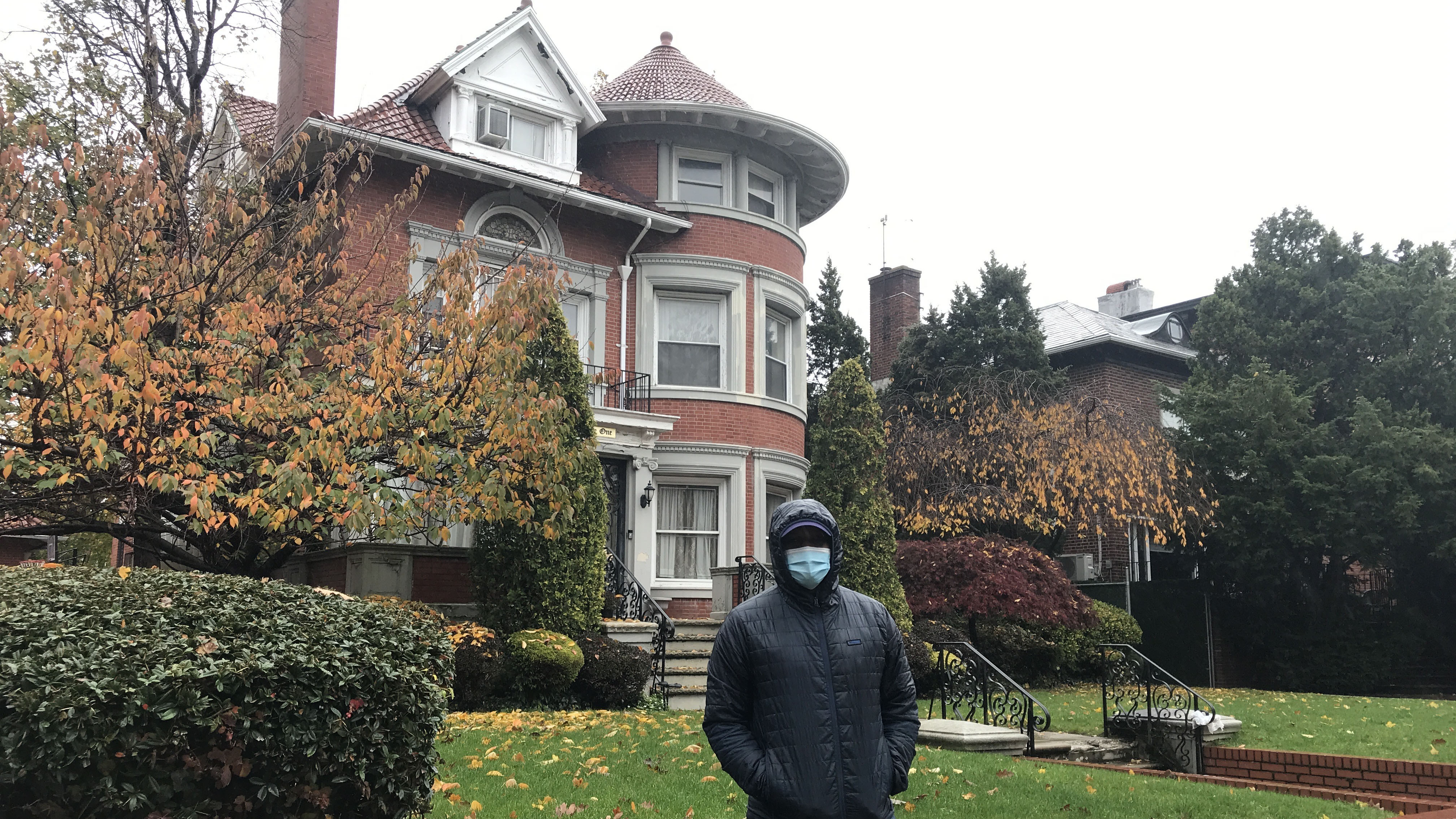
Fire, floods and other disasters have another side effect: The power goes out. A key theme of adaptation and resilience is actually decentralization. A sort of self-sufficiency, whether that “self” is a house, a business or even a city. And when it comes to energy, it means moving off one big central grid and creating little islands of power in cities, neighborhoods and individual homes.
People are doing it with solar-powered backup systems, even microgrids, little localized power plants that generate, store and distribute power. But the key to any of those systems is the storage part. And where do you store power? Batteries.
Batteries, as it happens, are also the key to electrification of cars and buses and other systems that currently rely on fossil fuels. So lots and lots of money and research is going into building a better battery.
Gerd Ceder and Kristin Persson are working on it. They’re professors of materials science and engineering at University of California, Berkeley. They are also married, and both work on battery technology. Sometimes together, sometimes in friendly competition.
Ceder says the way to think about decentralization is sort of like the jump from mainframe computers to personal computers.
“The utilities today are the mainframe vendors, right? And they haven’t quite realized that the future is in small distributed computing. And if you look at that parallel, in 30 years, distributed computing has completely obliterated any mainframe computing, even supercomputer centers today,” Ceder said. “People think of a supercomputer, which is essentially a set of distributed computers. And of course, the grid is going to do this on a much longer time scale. And there are regulatory hurdles and utilities themselves probably stand in the way here. But this is the future of the grid: a sort of dynamic marketplace of electricity between a lot of small players.”
So microgrids are like the iPhones of future power. But you know how your iPhone battery dies in a day? Today’s lithium-ion batteries are about at their max in terms of the amount of energy they can store. They also rely on cobalt and nickel, both of which are limited resources and … with some pretty sketchy mining practices attached to them.

Oh, and they’re unstable and they sometimes explode. But they’re still really hard to improve on. Ceder, for example, is working with a class of materials called disordered rock salts to fundamentally change the structure of lithium-ion batteries and the materials that make up the parts called the cathode and the anode. That would change how the lithium flows within the battery and could increase its energy storage. But there’s a lot more going on. Prepare to geek out a little.
Gerd Ceder: This is really our only path forward to make 10 terawatt hours. If you listen to Elon Musk and his Battery Day, he sees the world in 2030 as generating 20 terawatt hour of battery capacity each year. To put that in perspective, that’s probably about 40 times what we make today. So there is no way we can do that with today’s materials. And after that there are also other things we work on [that] maybe Kristin wants to talk a bit about. Things like multivalent technology, things that are even further out.
Kristin Persson: So I think what is useful from the battery community’s perspective is that we don’t work on just one possible avenue going forward. From a fundamental perspective, we don’t really know what kind of hurdles are going to be in terms of manufacturing, in terms of cost. It’s a huge problem trying to project what is going to be the battery material in lithium-ion batteries or lithium metal batteries 15 years from now. So, the community is working, I would say, on a diverse set of solutions, with different timescales associated with them. For example, in the Joint Center for Energy Storage Research, which is centered in [Argonne National Laboratory], we’re collaborators. We are working on things that are even further away. For example, what if we could use calcium or magnesium multivalent ions that are shuttled between the anode and the cathode, so they are two plus. Which means that if you can make that work, you can get double the capacity, double the number of electrons for each ion that gets shot between them. There is an obvious gain there, theoretically, but there are many challenges in terms of stability of the different materials. So we are working on different kinds of materials, figuring out, how do we make these ions move in cathodes and anodes that normally wouldn’t have worked?
Ceder: If I may add one more quick thing. People at Berkeley and [the Lawrence Berkeley National Laboratory] are also working on complete solid-state batteries, which is really a game changer. Today batteries contain a liquid electrolyte. It really is sort of like the old-school electrolyte: You put two electrodes in a beaker of water and the water’s your electrolyte. You move things back and forth between the electrodes. But the electrolyte in lithium-ion batteries is actually the source of the flammability. And so people are now trying to make complete solid-state batteries, with no liquids around. They could have potentially extremely high-energy density, but they will also be, and this is important, really safe. And once you make safe batteries, you can gain in so many ways because you don’t need all the auxiliary equipment to cool the batteries or to protect them if something goes wrong. And so there are multiple really important and exciting directions that the battlefield is pushing.
Persson: Maybe we should say safer. I’ve heard that there can be battery fires even with solid-state batteries. It’s just a rumor but I’ve heard of it. [Laughs]
Ceder: Whose lab would that have been in? Hmm. I don’t know. I have no idea.
Persson: [Laughs]
Wood: I love the idea that you could be working on competing technologies, too.
Persson: Yeah, it’s a friendly competition.
Wood: Multivalent is the jam. Solid state is done.
Persson: Totally. Totally. And they’re all safe and we’re never gonna have a battery fire ever again.
Wood: Never, never again.
If you got lost in all the science, the upshot is there are no simple answers to this technology and it’s going to take a while. But Ceder and Persson said this area of research is well-funded by both governments and companies. And there’s plenty of interest in getting it right.
Self-sufficiency is also a business opportunity.
On a rainy day this fall in Brooklyn’s Crown Heights neighborhood, a crew was taking stock of the heating system at the parsonage for Cornerstone Baptist Church, a nearly century-old building. The house is brick, 4 stories tall and has a big turret in one corner. But the heating system uses oil — and it’s really inefficient.
“Once you get everything heated, you have to turn on some air, just to balance out the heat,” said Cornerstone Pastor Lawrence Aker, who’s lived in the house with his family for nearly 20 years.

That’s right. They have to turn on the air conditioning in the dead of winter because the oil heat makes the home too warm. And all that inefficiency adds up. Just the oil bill alone costs about $30,000 a year.
The startup BlocPower uses software to identify buildings that are prime candidates to receive more efficient energy systems. In Cornerstone’s case, the company is installing an electric heat pump. For other buildings, that might mean installing a microgrid to make the power system self-sufficient. BlocPower also works with commercial apartment buildings and public housing in addition to single-family homes and works to train local construction crews to install the modern systems. The company operates in New York, Oakland, California, and Milwaukee, with plans to expand to Baltimore, Washington, Los Angeles and Chicago. It has worked on 850 buildings in Brooklyn alone.
Donnel Baird, BlocPower’s founder and CEO, said retrofitting buildings like this one is a way to build more resilient cities.
“At the individual building level, the building is more comfortable. It saves money, it uses less fossil fuels. But at the neighborhood or borough level, the entire grid is smarter and greener and more resilient,” Baird said. “Instead of investing a billion dollars in fossil fuel infrastructure, which is expensive and not resilient, we’re investing in distributed solar battery electrification projects to make the Brooklyn grid more resistant.”
Baird grew up in Brooklyn himself, in a family without much money. They would turn on the oven to heat their apartment. I talked with him about how BlocPower works.
Donnel Baird: We’ve built a recommendation engine that allows a user to type in a building’s address and pull up a set of preliminary recommendations on what kind of sustainability equipment should go into their building. We use a mix of big data, machine learning, some fancy statistics, mechanical engineering. We’ve built out an algorithm that allows us to make those recommendations, so that’s the software component. It helps us and utility companies and governments and building owners to determine what kind of equipment makes sense in each and every building. And then it allows us to develop a financial model of what returns to an investor or a bank might look like if they decided to finance a particular clean energy project in a particular building.
Wood: You have the data, [and] building owners can go and look up their address and say, “Oh, it would cost me this much.” But then you also close the loop, right? You do the retrofitting yourself?
Baird: We finance and install and project manage the project. So for a 10-unit apartment building in the Bronx, it may cost a half-million dollars to replace all of their fossil fuel heating and cooling and hot water with 100% renewable energy-powered energy systems. They don’t have that half-million dollars laying around, so we finance it. We identify and train a local mom and pop construction company. We get them trained by the manufacturer of the equipment, and we project manage the installation of the equipment that we finance.
Wood: And then where does the financing come from on the back-end?
Baird: We have to negotiate with banks, so we have a partnership with an investment bank. The New York state government has a green bank, and they’ve loaned us $5 million to invest in clean energy projects. And we have a new partnership with Goldman Sachs, where we’re borrowing $50 million to finance projects across New York City.
Wood: I’m very curious about the financial instruments that are making investments in renewable energy, for example, possible. Like, is this an opportunity for investment banks to then say, “We have these green investments,” even if the returns are not huge over time or take a long time?
Baird: Absolutely. We think that there is an opportunity to develop a new asset class, a new financial asset, a structured financial product, that allows investment banks and pension funds to invest in distributed clean energy technology across America, across the world, and create a new asset class that provides them 5% to 15% rates of returns, depending on what kind of investments they make. And it doesn’t correlate with the stock market, so it’s an interesting new kind of investment. Machine learning, cloud computing, mobile computing — the cost of those technologies has declined dramatically. The cost of solar, the cost of smart, green heating systems in urban buildings has declined. That allows us to create this new asset class where banks and pension funds can finance these assets.
Wood: But it seems to me that on its face, like, a 12-to-15-year return timeline is long. These are very capital-intensive buildouts. The returns might not be huge. It sounds to me like you have a sort of data-and-this-asset-class play that, long term, could really be impactful.
Baird: Yeah. You can think about it as a green infrastructure bond for urban, clean energy. So the returns will be bondlike. They’re not going to be like the stock market, but they’ll be stable — you, as an investor, financing a particular asset out there in the real world that’s going to have some financial returns. So it’s a different kind of instrument, but it can be really huge. And if you’re talking about introducing environmentally sustainable technologies to the real estate sector, across the world, I mean, that’s just a massive investment opportunity, so we think it’s going to be a great, new asset class.
Wood: Which is a supercool business for you. Does it sometimes feel like something that governments could be doing, selling green energy investment funds?
Baird: [Laughter]
Wood: I hate to state the obvious so obviously, but what a good idea.
Baird: Well, it actually comes from the government. I was a senior staffer for the Obama campaign, the first one. And when we won, I didn’t want to move to D.C. My assignment instead was to work with the coalition of labor union pension funds. The idea was how could these pension funds use federal stimulus dollars to create green municipal bonds? But it’s really complicated to do. And 10 years ago, we didn’t have the technology that allowed us to pull it off. So really, it is the decline in the cost of the software that we’re using, as well as some significant advances in the heating equipment itself. So, I do think at scale we do hope that local municipal governments start to structure green infrastructure bonds for the Bronx, or for Chicago or for Detroit, that institutional investors can purchase.
We know that addressing climate change and investing in adaptation and resilience will take a lot of money. But increasingly, banks and financial institutions recognize the risks of not dealing with climate change and the opportunity for new financial tools and types of investment. Even Federal Reserve Chair Jerome Powell said this fall that central bankers should consider climate change risk in assessing financial stability and even bank regulations.
Virtually all regions of the U.S. have felt the climate changing. The hot days are hotter, the snowy days are snowier, the fire seasons are longer and more dangerous and the hurricanes … well, we run out of names for them. That this extreme weather is occurring at the same time as a pandemic that’s upended so much about our lives has shown that the worst can happen. That things like climate change or plagues aren’t just history or forecasts or models or theories. They’re part of life.
It’ll take a massive investment to slow down global warming. But it will also take a massive investment to make cities and towns and homes and countries resilient to climate change. In some ways, that investment is already starting. Some of this is like boiling the proverbial frog: We might not even think of it explicitly as adaptation. But we know the weather is changing and we have to change with it.
The first step is changing how we think. We need to think less about the seemingly unsolvable, global-scale problem and more about the solutions. That’s how we adapt. That’s how we survive.
Click here to read and listen to Part 1 on the changing climate mindset.
Click here to read and listen to Part 2 on coping with drought and fire.
“How We Survive: Adapting to Climate Change” was edited by Michael Lipkin and produced by Stephanie Hughes with help from Jesús Alvarado and Rose Conlon. Scoring and engineering by Robyn Edgar and Ben Tolliday. Original music composed by Ben Tolliday.
There’s a lot happening in the world. Through it all, Marketplace is here for you.
You rely on Marketplace to break down the world’s events and tell you how it affects you in a fact-based, approachable way. We rely on your financial support to keep making that possible.
Your donation today powers the independent journalism that you rely on. For just $5/month, you can help sustain Marketplace so we can keep reporting on the things that matter to you.


















